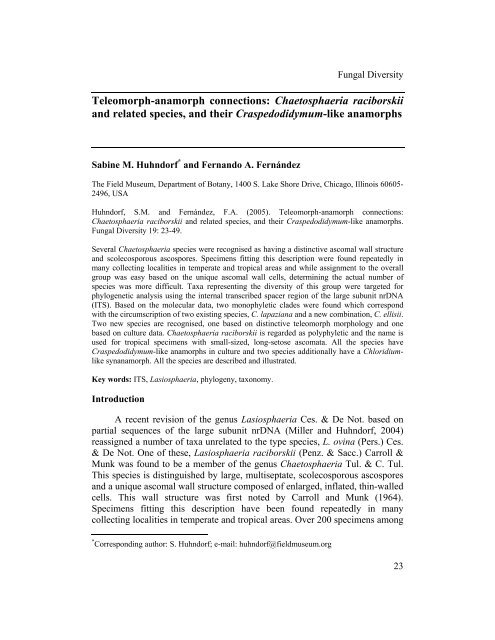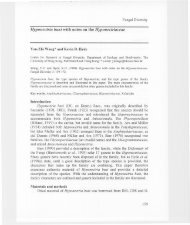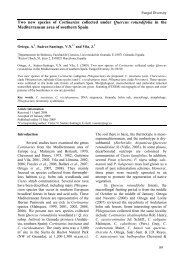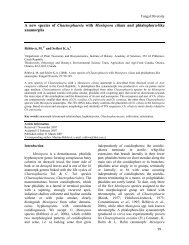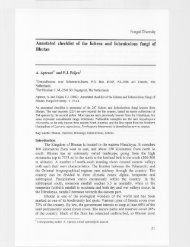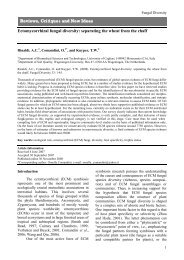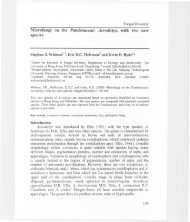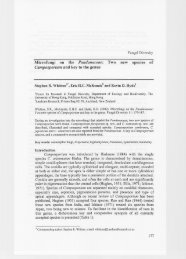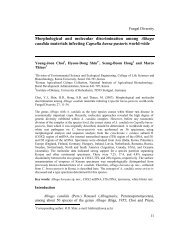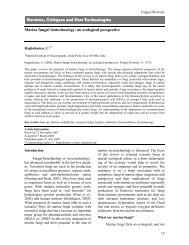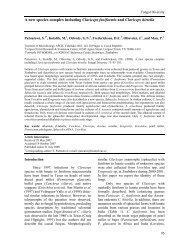Teleomorph-anamorph connections ... - Fungal diversity
Teleomorph-anamorph connections ... - Fungal diversity
Teleomorph-anamorph connections ... - Fungal diversity
Create successful ePaper yourself
Turn your PDF publications into a flip-book with our unique Google optimized e-Paper software.
<strong>Fungal</strong> Diversity<br />
<strong>Teleomorph</strong>-<strong>anamorph</strong> <strong>connections</strong>: Chaetosphaeria raciborskii<br />
and related species, and their Craspedodidymum-like <strong>anamorph</strong>s<br />
Sabine M. Huhndorf * and Fernando A. Fernández<br />
The Field Museum, Department of Botany, 1400 S. Lake Shore Drive, Chicago, Illinois 60605-<br />
2496, USA<br />
Huhndorf, S.M. and Fernández, F.A. (2005). <strong>Teleomorph</strong>-<strong>anamorph</strong> <strong>connections</strong>:<br />
Chaetosphaeria raciborskii and related species, and their Craspedodidymum-like <strong>anamorph</strong>s.<br />
<strong>Fungal</strong> Diversity 19: 23-49.<br />
Several Chaetosphaeria species were recognised as having a distinctive ascomal wall structure<br />
and scolecosporous ascospores. Specimens fitting this description were found repeatedly in<br />
many collecting localities in temperate and tropical areas and while assignment to the overall<br />
group was easy based on the unique ascomal wall cells, determining the actual number of<br />
species was more difficult. Taxa representing the <strong>diversity</strong> of this group were targeted for<br />
phylogenetic analysis using the internal transcribed spacer region of the large subunit nrDNA<br />
(ITS). Based on the molecular data, two monophyletic clades were found which correspond<br />
with the circumscription of two existing species, C. lapaziana and a new combination, C. ellisii.<br />
Two new species are recognised, one based on distinctive teleomorph morphology and one<br />
based on culture data. Chaetosphaeria raciborskii is regarded as polyphyletic and the name is<br />
used for tropical specimens with small-sized, long-setose ascomata. All the species have<br />
Craspedodidymum-like <strong>anamorph</strong>s in culture and two species additionally have a Chloridiumlike<br />
syn<strong>anamorph</strong>. All the species are described and illustrated.<br />
Key words: ITS, Lasiosphaeria, phylogeny, taxonomy.<br />
Introduction<br />
A recent revision of the genus Lasiosphaeria Ces. & De Not. based on<br />
partial sequences of the large subunit nrDNA (Miller and Huhndorf, 2004)<br />
reassigned a number of taxa unrelated to the type species, L. ovina (Pers.) Ces.<br />
& De Not. One of these, Lasiosphaeria raciborskii (Penz. & Sacc.) Carroll &<br />
Munk was found to be a member of the genus Chaetosphaeria Tul. & C. Tul.<br />
This species is distinguished by large, multiseptate, scolecosporous ascospores<br />
and a unique ascomal wall structure composed of enlarged, inflated, thin-walled<br />
cells. This wall structure was first noted by Carroll and Munk (1964).<br />
Specimens fitting this description have been found repeatedly in many<br />
collecting localities in temperate and tropical areas. Over 200 specimens among<br />
* Corresponding author: S. Huhndorf; e-mail: huhndorf@fieldmuseum.org<br />
23
our collections fit into the broad interpretation of this species complex or group.<br />
They are found on a variety of decayed substrates especially on welldecorticated,<br />
watersoaked wood. Ascomata on the substrate are superficial,<br />
mostly gregarious ranging in size from small (Fig. 44) to very large (Fig. 26).<br />
Setae may or may not be present on the ascomata and when present may vary in<br />
length. The ascomatal wall structure is the most distinguishing feature and it<br />
serves as a major morphological character to separate this species from other<br />
Chaetosphaeria species.<br />
While initial assignment to this group was easy based on the presence of<br />
the distinctive wall cells, determining the actual number of species involved<br />
proved to be more difficult. A considerable amount of variation exists within<br />
several of the morphological characters making for a very large and diverse<br />
group of specimens. In this study, specimens representing the morphological<br />
<strong>diversity</strong> were examined, characterised and described. Available cultures were<br />
targeted for phylogenetic analysis using the internal transcribed spacer (ITS)<br />
region of the nuclear ribosomal DNA. Some questions we considered were: (1)<br />
Does variation in the ascomal or ascospore morphologies correspond to one or<br />
more species? (2) Do analyses of the ITS data provide groupings concordant<br />
with groupings having similar morphologies? (3) What information does<br />
culture and <strong>anamorph</strong> data provide?<br />
Materials and methods<br />
Morphological<br />
Ascomata were mounted in water and replaced with lactophenol<br />
containing azure A. Measurements were made and images were captured of<br />
material in both mounting fluids. Ascomata were sectioned at 5 µm for light<br />
microscopy using techniques modified from Huhndorf (1991): the use of<br />
osmium tetroxide as a secondary fixative is discontinued, acetone is used for<br />
dehydration in place of ethanol and Spurr’s embedding medium replaces the<br />
Low Viscosity medium no longer available. Images were captured using<br />
photomacrography, bright field (BF), phase contrast (PH) and differential<br />
interference microscopy (DIC) and photographic plates were produced<br />
following the methods of Huhndorf and Fernández (1998). Abbreviations for<br />
collectors are SMH = S.M. Huhndorf, FAF = F.A. Fernández and ANM = A.N.<br />
Miller. When no collector is listed, the collector is identified by the collection<br />
number. All SMH collections are deposited in the Field Museum Mycology<br />
Herbarium (F). Latitude and longitude are given in degrees or calculated<br />
decimal equivalents. All specimens were collected from decorticated wood<br />
unless otherwise noted.<br />
24
Taxon sampling<br />
<strong>Fungal</strong> Diversity<br />
Taxa used in this study are listed in Table 1 along with their geographical<br />
locality, collector, voucher specimen and/or isolate number, and GenBank<br />
accession number. Cultures of multispore isolates were obtained by spreading<br />
centrum material from air-dried specimens onto 1% water agar (Difco agar) in<br />
60 mm diam. plastic Petri plates. After 24-48 hours of incubation at room<br />
temperature, germinated asci and ascospores were transferred to 60 mm diam.<br />
plastic Petri plates containing 1% corn meal agar (Difco). Cultures were<br />
maintained at 10ºC on 1% potato dextrose agar (Difco) slants in screw-cap<br />
tubes (23 × 85 mm, 6 dram). All voucher specimens are deposited in the Field<br />
Museum Mycology Herbarium (F). Selected cultures are deposited at ATCC.<br />
DNA extraction, PCR amplification, sequencing and sequence alignment<br />
Isolates were either grown in 1.5 mL microcentrifuge tubes containing 10<br />
mL of potato dextrose broth (Difco) or grown in 9 cm diam. Petri plates<br />
containing cornmeal agar (Difco). Mycelium was either collected from the<br />
broth or scraped from the cornmeal agar’s surface in plates; washed and<br />
centrifuged twice in deionised sterile water. Total genomic DNA was extracted<br />
as described in Fernández et al. (1999). DNA extractions from ascomata from<br />
additional collections were also attempted but were unsuccessful.<br />
The ITS region of the nrDNA was amplified by using reagents in a Replipack<br />
Reagent set (Boehringer Mannheim Corporation, Indianapolis, Indiana) in<br />
the following manner: 1.5 µL of 25 mM MgCl2, 2.5 µL of 10× reaction buffer<br />
(100 mM Tris, 500 mM KCl, pH 8.3), 0.5 µL of 8 mM dNTPs, 1.25 µL each of<br />
20 mM primers ITS5 and ITS4 (White et al., 1990), 0.25 µL (1.25 units) of Taq<br />
DNA polymerase, 1 µL of the undiluted DNA extract and 16.75 µL of double<br />
distilled, sterile water for a 25 µL total reaction volume.<br />
PCR was performed by using the following thermocycling parameters:<br />
initial denaturation temperature 95ºC for 2 minutes, followed by 35 cycles of<br />
denaturation at 95ºC for 1 minute, annealing at 50ºC for 1 minute and extension<br />
at 72ºC for 1 minute. A final extension step of 10 minutes at 72ºC was added.<br />
Amplified products were separated from unincorporated nucleotides and<br />
primers by using a Geneclean III kit (Bio 101, Inc., Vista, California).<br />
Sequencing was performed on both strands using primers ITS5/ITS1 and<br />
ITS4 (White et al., 1990). Sequencing reactions were performed by using the<br />
ABI Prism Dye Terminator Cycle Sequencing kit (Perkin-Elmer Corporation).<br />
Sequenced products were cleaned by precipitation using a 70% ethanol/5 mM<br />
Magnesium chloride solution, and were run through a polyacrylamide gel using<br />
25
Table 1. List of taxa used in the molecular analyses. All sequences are from the internal<br />
transcribed spacer region of the nrDNA.<br />
Taxa Culture designation Geopolitical origin GenBank<br />
Accession No.<br />
C. ellisii SMH2519 USA (Indiana) AY906939<br />
C. ellisii SMH2758 USA (North Carolina) AY906940<br />
C. ellisii SMH3807 USA (North Carolina) AY906941<br />
C. ellisii SMH3809 USA (North Carolina) AY906942<br />
C. ellisii SMH3824 USA (North Carolina) AY906943<br />
C. ellisii SMH3860 USA (South Carolina) AY906944<br />
C. hebetiseta SMH2729 USA (North Carolina) AY906955<br />
C. innumera SMH2748 USA (North Carolina) AY906956<br />
C. lapaziana SMH2182 Costa Rica AY906945<br />
C. lapaziana SMH2900 Puerto Rico AY906946<br />
C. lapaziana SMH3043 Puerto Rico AY906947<br />
C. panamensis SMH3596 Panama AY906948<br />
C. raciborskii SMH2017 Puerto Rico AY906949<br />
C. raciborskii SMH2036 Puerto Rico AY906950<br />
C. raciborskii SMH2132 Puerto Rico AY906951<br />
C. raciborskii SMH3014 Puerto Rico AY906952<br />
C. raciborskii SMH3119 Puerto Rico AY906953<br />
C. rubicunda SMH2881 Puerto Rico AY906954<br />
an ABI Prism 377 DNA Sequencer (Applied Biosystems). Eighteen sequences<br />
were assembled and aligned by using Sequencher version 3.0 (Gene Codes<br />
Corporation), including C. hebetiseta and C. innumera as outgroups. Alignment<br />
was checked by eye and corrected manually when necessary. Parsimony<br />
analyses were performed using PAUP* 4.0b64a compiled for the PPC platform<br />
(Swofford, 2000). Parsimony informative characters were unordered and were<br />
unequally weighted by subjecting them to a transition/transversion-ratio step<br />
matrix. Gaps were treated as missing, 10,000 random-addition sequence<br />
replicates were implemented for the analysis, the branch-swapping algorithm<br />
was TBR, the MULPARS option was in effect, and zero-length branches were<br />
not collapsed. The support for the internodes of the most-parsimonious trees<br />
was estimated by 10,000 bootstrap replicates (Felsenstein, 1985) with a<br />
heuristic search with 10 random-addition sequences for each of 1000 bootstrap<br />
replicates.<br />
Results<br />
Molecular<br />
The parsimony analysis yielded a total of 486 characters, of which 313<br />
were constant, 57 were variable parsimony-uninformative and 99 were<br />
26
<strong>Fungal</strong> Diversity<br />
parsimony-informative. The analysis generated four most parsimonious trees of<br />
371 steps, CI = 0.68, with identical topology (Fig. 104).<br />
Placement of C. raciborskii within the genus Chaetosphaeria is well<br />
supported according to parsimony analyses of partial sequences of the large<br />
subunit nrDNA and the β-tubulin gene (Fernández et al., pers. observ.; Miller<br />
and Huhndorf, 2004). The outgroup taxa, represented by Chaetosphaeria<br />
innumera and Chaetosphaeria hebetiseta, are very unlike the ingroup taxa.<br />
Both species have small fusiform, three-septate, hyaline ascospores whereas the<br />
ingroup taxa have scolecosporous, seven-septate, hyaline ascospores.<br />
The 16 collections composing the ingroup segregated into three distinct<br />
clades that have strong bootstrap support (Fig. 104). Clade 1 (= C. ellisii) is<br />
composed of all six temperate collections (NC and IN) with small to medium<br />
size ascomata having short setae over the entire surface. Clades 2 and 3 contain<br />
only tropical collections (PR and CR) with clade 2 (= C. raciborskii; two<br />
collections) having small to medium size ascomata with long setae over the<br />
entire surface and clade 3 (= C. lapaziana; three collections) having large<br />
ascomata with no setae or setae only at the apex. Collection SMH3014 shows<br />
affinities with clade 3 without bootstrap support, however morphologically it<br />
more closely resembles C. raciborskii. The three remaining collections from<br />
Puerto Rico form a clade without bootstrap support. One collection (SMH2881)<br />
is described as a new species while the other two collections resemble C.<br />
raciborskii. Collection SMH3596 from Panama consistently segregates from<br />
the rest of the collections, and putatively represents an additional clade (clade<br />
4) composed of small sized ascomata with setae. This specimen produces<br />
unique, purple aleuriospores in culture (Figs. 57, 58, 61) and is described as a<br />
new species.<br />
Total ITS sequence variation percentages, calculated as the number of<br />
base changes divided by the total number of bases, was lower among six<br />
temperate specimens (ca. 4.8%) compared to that among seven specimens from<br />
Puerto Rico (ca. 21.4%). Based on the analysis of ITS sequence data, four<br />
separate species are recognised, three monophyletic (clades 1, 3 and 4) and one<br />
paraphyletic (clade 2 and the additional unsupported collections) (Fig. 104).<br />
Recognition of these species is supported by morphological, cultural, and<br />
geographic data. One additional species is recognised based solely on<br />
morphology of the teleomorph (SMH2881).<br />
Taxonomy: new species and combinations<br />
Chaetosphaeria ellisii (Barr) Huhndorf & F.A. Fernández, comb. nov.<br />
(Figs. 1-23)<br />
≡ Lasiosphaeria ellisii Barr, Mycotaxon 46: 48. 1993. (Basionym)<br />
27
≡ Sphaeria longispora Ellis, non Currey, nec Karsten (see Barr 1993 for additional<br />
synonymies).<br />
Ascomata scattered or clustered, numerous, superficial, globose to ovoid,<br />
not collapsing, roughened, with reddish, russet or brown surface colour, (130-)<br />
150-300(-375) µm diam., 150-325(-420) µm high, papillate. Setae scattered<br />
over entire ascoma, brown, stiff, pointed, arising from the inner layer of small<br />
brown cells, long, 20-45 µm, sparse or abundant. Ascomatal wall of textura<br />
globosa in surface view; in longitudinal section uniformly 36-110 µm thick; 2layered,<br />
inner wall layer 15-19 µm thick, up to 60 µm thick at base, composed<br />
of small (4 × 8 µm), polygonal-to-elongate, pale-to-dark brown,<br />
pseudoparenchymatic cells, 4-6 cells thick, setae arising from this wall layer;<br />
outer wall layer 34-51 µm thick, composed of large (15-30 × 27-37 µm),<br />
isodiametric-to-polygonal, pale brown, pseudoparenchymatic cells, 5-20 cells<br />
thick, when fresh some of the cells contain pale purple pigment, disappearing<br />
when dried. Papilla conical, 58-60 µm high, 14-17 µm wide at the apex, 43-49<br />
µm wide at the base; circular ostiole 15-27 µm wide, with periphyses.<br />
Paraphyses 3-4 µm wide, numerous, septate, tapering toward apex. Asci 162-<br />
180 × 10-15 µm, numerous, arising from basal hymenium, cylindrical, rounded<br />
apex, with refractive apical ring, short-stalked, unitunicate, with 8, triseriate,<br />
ascospores. Ascospores (40-)50-75(-80) × 3-4.5 µm, filiform, with apical end<br />
broadly rounded, basal end narrowly rounded, straight to slightly curved,<br />
hyaline, smooth, 7-septate, without constrictions, primary septum median,<br />
slightly bipolarly asymmetrical, without sheath or appendages. Culture:<br />
Colonies on WA hyaline to light brown, mostly immersed with sparse<br />
superficial hyphal growth, 12-24(-39) mm in 21 days, <strong>anamorph</strong>s present or<br />
absent. Colonies on CMA hyaline to light brown, mostly immersed with sparse<br />
superficial hyphal growth, 10-25(-40) mm in 21 days, <strong>anamorph</strong>s present or<br />
absent. Colonies on MEA light brown to dark-greenish brown, reverse dark<br />
brown, abundant immersed and superficial floccose hyphal growth, 11-20(-40)<br />
mm in 21 days, no <strong>anamorph</strong>s produced. Some isolates on WA and CMA<br />
produced two syn<strong>anamorph</strong>s at 7-14 days. Craspedodidymum-like <strong>anamorph</strong><br />
consists of simple phialidic conidiogenous cells on hyphae or multi-celled,<br />
Figs. 1-23. Chaetosphaeria ellisii. 1, 2, 11. Ascomata on substrate. 3, 12. Section through<br />
ascomal neck. 4. Longitudinal section through ascoma. 5, 13. Section through ascomal wall. 6,<br />
10. Pieces of the ascomal wall showing the wall cells and setae. 7, 14. Asci. 8, 15, 19.<br />
Ascospores. 9. Ascus apex. 16-18, 20, 21. Craspedodidymum-like conidiophores on CMA. 22.<br />
Conidia on CMA. 23. Chloridium-like conidiophores on CMA. Figs. 1, 2, 11 by<br />
photomacrography; Figs. 3-10, 12-23 by DIC. Figs. 1-5, 7, 8 from holotype Ellis coll (NY);<br />
Figs. 6, 9, 10 from Cooke 119 (NY); Figs. 11, 12, 14, 18, 19, 23 from SMH2519; Fig. 13 from<br />
SMH3807; Fig. 15 from SMH3824; Figs. 16, 20, 22 from SMH2758; Fig. 17 from SMH3809;<br />
Fig. 21 from SMH3860. Bars: 1, 2, 11 = 200 µm; 4 = 100 µm; 3, 5-10, 12-23 = 10 µm.<br />
28
<strong>Fungal</strong> Diversity<br />
29
own conidiophores, at times more than one phialide is produced on a<br />
conidiophore or a phialide proliferates percurrently; phialides flask-shaped to<br />
obclavate, 6-8 µm diam, 7-19 µm high, brown, collarette flared or cup-shaped,<br />
5-9 µm wide, 1.5-3(-5) µm high. Conidia globose, to subglobose, 10-13.5 µm<br />
diam, thick-walled, hyaline, one-celled; large and small guttules in the mature<br />
conidium. Chloridium-like <strong>anamorph</strong> consists of simple phialidic<br />
conidiogenous cells on a multi-celled, brown conidiophore, 60-125 × 2.5-3.5<br />
µm; phialides cylindrical, mostly terminal, 2.5-4 µm diam, 8-19 µm high,<br />
sometimes with a small collarette (3-4 µm wide, 1.5-2 µm high), conidia<br />
produced percurrently, accumulating in large clusters at phialide’s tip. Conidia<br />
globose to ovoid to clavate, 5-12 × 2-8.5 µm, one-celled, hyaline, sometimes<br />
with a blunt basal end.<br />
Anamorph: Craspedodidymum-like and Chloridium-like.<br />
Habitat: On decorticated wood.<br />
Known distribution: USA.<br />
Material examined: USA, Illinois, Alexander Co., toward Bean Ridge Pond along Forest<br />
Road 262, 13-VIII-1999, ANM, SMH4129; Cook Co., Cook County Forest Preserve, Swallow<br />
Cliffs, 3-VII-1996, SMH, FAF, M. Huhndorf, SMH2541; SMH2542; SMH2543; SMH2544; 16-<br />
VIII-1996, SMH2638; 31-X-1997, SMH3768; Ogle Co., White Pines Forest State Park, 28-IX-<br />
1996, SMH, FAF, SMH2690; SMH2699; SMH2703; Vermillion Co., Kennekuk Co. Park,<br />
Lookout Point trail by Oak Bluff picnic area, W of Middle Fork Vermillion River, [40.1833, -<br />
87.7333], 29-IX-2000, ANM, SMH4328. Indiana, Brown Co., Yellowwood State Forest,<br />
compartment 7, tract 24, 26-VII-1996, SMH2634; Lake Co., Indiana Dunes National Lakeshore,<br />
Cowles Bog, 1-VII-1996, SMH, FAF, M. Huhndorf, SMH2519; SMH2520. Michigan, Berrien<br />
Co., Warren Woods, south end of trail, through picnic area, up to creek, 8-IX-1998, FAF,<br />
ANM, SMH3884; SMH3889; SMH3893; SMH3898; north end trail, 29-IX-1998, FAF, ANM,<br />
SMH3901; 31-VIII-1999, ANM, SMH4134. New Jersey, Newfield, 20-VII-1874, on branch of<br />
Kalmia latifolia on the ground, J.B. Ellis (NY; holotype). New York, Clyde, IX-1881, O.F.<br />
Cooke 119 (NY). North Carolina, Macon Co., Franklin, Standing Indian Campground, Park<br />
Creek Trail, towards gravel road, [35.0079, -83.5305], 29-VII-1998, FAF, SMH3841;<br />
Highlands, Blue Valley, 1000 m, [35.0192, -83.2736], 7-X-1996, SMH, FAF, Q.X. Wu, J.C.<br />
Wei, G.M. Mueller, SMH2735; 18-VII-1997, FAF, SMH3267; SMH3272; Highlands Biological<br />
Station, 20-VII-1997, FAF, SMH3299; SMH3302; SMH3304; 21-VII-1997, FAF, SMH3312;<br />
Horse Cove Drive & Bull Pen Road, 1000 m, [35.025, -83.1464], 5-X-1996, FAF, Q.X. Wu,<br />
J.C. Wei, SMH2734; 8-X-1996, SMH, FAF, Q.X. Wu, J.C. Wei, G.M. Mueller, SMH2758; 27-<br />
VII-1998, FAF, SMH3816; SMH3824; Otto, Cowieta Hydrological Laboratory, 27-VII-1998,<br />
FAF, SMH3805; SMH3807; SMH3809; 19-VII-1997, FAF, SMH3283; SMH3285; Oconee Co.,<br />
Sumter National Forest Fish Hatchery, left trail through pine area to East Fork Trail, [34.9836, -<br />
83.0739], 31-VII-1998, FAF, SMH3860. Wisconsin, Fond du Lac Co., Kettle Moraine State<br />
Forest, Mantle Lake Rec. Area, wet area scenic trail, 24-IX-1999, SMH, SMH4190.<br />
Chaetosphaeria lapaziana (Carroll & Munk) F.A. Fernández & Huhndorf,<br />
<strong>Fungal</strong> Diversity 18: 48 (2005) (Figs. 24-43)<br />
Ascomata clustered, numerous, superficial, globose to ovoid, not<br />
collapsing, roughened, with reddish, russet or brown surface colour, (400-)500-<br />
30
<strong>Fungal</strong> Diversity<br />
950 µm diam., 525-825(-1025) µm high, papillate. Setae absent or only<br />
surrounding the ostiole, brown, stiff, pointed, short, 25-35 µm, sparse.<br />
Ascomatal wall of textura globosa in surface view; in longitudinal section<br />
uniformly 50-90(-145) µm thick; 2-layered, inner wall layer 10-30(-45) µm<br />
thick, composed of small, polygonal-to-elongate, pale-to-dark brown,<br />
pseudoparenchymatic cells, 4-6 cells thick, setae arising from this wall layer;<br />
outer wall layer 20-65(-115) µm thick, composed of variable-sized (largest<br />
range from 30-39 × 46-56 µm), isodiametric-to-polygonal, pale brown,<br />
pseudoparenchymatic cells, 5-20 cells thick, when fresh some of the cells<br />
contain pale purple pigment, disappearing when dried. Papilla conical, at times<br />
composed of apical setae 25-35 µm long; (50-)85-125 µm high, 25-45 µm wide<br />
at the apex, 65-150 µm wide at the base; circular ostiole 35-85 µm wide, with<br />
periphyses. Paraphyses 3-4 µm wide, numerous, septate, tapering towards<br />
apex. Asci 170-290 × 11-25 µm, numerous, arising from basal hymenium,<br />
cylindrical, rounded apex, with refractive apical ring, short-stalked, unitunicate,<br />
with 8, triseriate, ascospores. Ascospores (45-)50-100(-120) × (3-)4.5-6(-7) µm,<br />
filiform to cylindrical, with apical end broadly rounded, basal end narrowly<br />
rounded, straight to slightly curved, hyaline, smooth, 7-septate, without<br />
constrictions, primary septum median, slightly bipolarly asymmetrical, without<br />
sheath or appendages. Culture: Colonies on WA hyaline to light brown, mostly<br />
immersed with sparse superficial hyphal growth, 17 mm in 21 days, <strong>anamorph</strong><br />
present over entire colony in 2 months. Colonies on CMA hyaline to light<br />
brown, mostly immersed with sparse superficial hyphal growth, 21 mm in 21<br />
days, <strong>anamorph</strong> present over entire colony in 2 months. Colonies on MEA light<br />
brown to dark-greenish brown, reverse dark brown, abundant immersed and<br />
superficial floccose hyphal growth, 24 mm in 21 days, no <strong>anamorph</strong>s produced.<br />
Craspedodidymum-like <strong>anamorph</strong> consists of simple phialidic conidiogenous<br />
cells on a multi-celled, brown conidiophore; phialides clavate, 8-10 µm diam,<br />
13-20 µm high, brown, collarette flared, rarely cup-shaped, 5-6.5 µm wide, 1-2<br />
µm high. Conidia oblate to horizontally oblong, 10.5-12.5 × 20-28 µm, hyaline,<br />
one-celled, with short abscission scar or frill located medially on one long side;<br />
large and small guttules in the mature conidium; more than one conidium<br />
produced per phialide.<br />
Anamorph: Craspedodidymum-like.<br />
Habitat: On decorticated wood<br />
Known distribution: Costa Rica, French Guiana, Jamaica, Puerto Rico.<br />
Material examined: COSTA RICA, Alajuela, La Fortuna de San Carlos, Parque<br />
Nacional Volcan Arenal, Pilón trail, [10.4419, -84.7167], 15-VII-2001, SMH, FAF, ANM, M.P.<br />
DaRin, SMH4532; SMH4551; La Paz, by waterfall, 1600 m, 13-VI-1962, G. Carroll, GC87<br />
(NY; holotype; IMI100173, isotype); Guanacaste, Parque Nacional Guanacaste, Santa Cecilia,<br />
Sector Pitilla, 700 m, [10.9889, -85.4261], 23-VI-1997, SMH3211; Puntarenas, San Vito, Las<br />
Cruces Biological Station, Rio Jaba trail, 1050 m, [8.7858, -82.9586], 5-V-1996, SMH, FAF,<br />
31
Figs. 24-43. Chaetosphaeria lapaziana. 24, 26, 32-34. Ascomata on substrate. 25, 35. Section<br />
through ascomal neck. 27, 43. Longitudinal section through ascoma. 28, 37-39. Ascospores.<br />
29. Section through ascomal wall. 30. Ascus apex. 31. Paraphyses. 36. Ascus. 40, 41.<br />
Craspedodidymum-like conidiophores on CMA. 42. Conidia on CMA. Figs. 24, 26, 32-34 by<br />
photomacrography; Figs. 25, 27-30, 35-43 by DIC; Fig. 31 by PH. Figs. 24-31 from holotype<br />
GC87 (NY); Figs. 32, 35, 38 from SMH3043; Figs. 34, 39 from SMH2900; Figs. 33, 36, 37,<br />
40-43 from SMH2182. Bars: 24, 32 = 500 µm; 26, 33, 34 = 200 µm; 27, 43 = 100 µm; 25, 28-<br />
31, 35-42 = 10 µm.<br />
32
<strong>Fungal</strong> Diversity<br />
SMH2182; SMH2188; SMH2193; Puntarenas, Parque Internacional La Amistad Pacifico, Los<br />
Alturas Biological Station, trail to Cerro Echandi, 1st 500 m, 1580 m, [8.95, -82.8333], 6-V-<br />
1996, SMH, FAF, SMH2244; SMH2251; SMH2253; San Jose, La Chonta, Km 55 on<br />
Interamerican Hwy, 2400 m, [9.6994, -83.9419], 9-V-1996, SMH, FAF, SMH2304; San<br />
Gerardo de Dota, Albergue de Montana, Savegre, Sendero la Quebrada, 2300 m, [9.55, -83.8],<br />
12-V-1996, SMH, FAF, SMH2408; 14-V-1996, SMH, FAF, SMH2458; SMH2464; SMH2466;<br />
Bosque los Ninos, 18-V-1996, SMH, FAF, SMH2502; SMH2505; SMH2509. FRENCH<br />
GUIANA, St-Laurent-du-Maroni Arrondissement, Canton de Maripasoula, Commune de Saul,<br />
Eaux Claires, 3rd stream crossing ca. 1 hr walk N along Route de Belizon, 200 m, [3.7, -53.2],<br />
4-IX-1994, SMH797. JAMAICA, St. Andrew Parish, Black Mts. Nat. Park, Fairy Glade trail,<br />
[18.0433, -76.3108], 17-VI-1999, FAF, SMH4103. PUERTO RICO, El Verde Research Area,<br />
Luquillo Mts., 16-ha Grid, 350 to 425 m, [18.3167, -65.8167], 12-I-1997, SMH, FAF,<br />
SMH2900; 16-I-1997, SMH, FAF, SMH3004; 18-I-1997, SMH, FAF, SMH3043.<br />
Chaetosphaeria panamensis Huhndorf & F.A. Fernández, sp. nov.<br />
(Figs. 44-64)<br />
Etymology: Refers to the collection locality.<br />
Ascomata dispersa, superficialia, globosa, 185-235 µm diametro, 190-270 µm alta,<br />
papillata, setae sparsae vel abundantes, brunneae, 60-75 µm altae. Paries superficie e textura<br />
globosa compositus, 30-40 µm crassus, pseudoparenchymaticus, e cellulis multangularibus vel<br />
elongatis compositus. Paraphyses simplices, septatae, hyalinae. Asci cylindrici, 123-140 × 10-<br />
11 µm, octospori. Ascosporae filiformes, 65-75 × 3-4 µm, hyalinae, 7-septatae.<br />
Ascomata scattered, sparse, superficial, globose, not collapsing,<br />
roughened, with reddish, russet or brown surface colour, setose, 185-235 µm<br />
diam., 190-270 µm high, papillate. Setae scattered over entire ascoma, brown,<br />
stiff, pointed, arising from the inner layer of small brown cells, 60-75 µm long,<br />
sparse or abundant. Ascomatal wall of textura globosa in surface view; in<br />
longitudinal section uniformly 30-40 µm thick; 2-layered, inner wall layer 5-10<br />
µm thick, composed of small, polygonal-to-elongate, pale-to-dark brown,<br />
pseudoparenchymatic cells, 4-6 cells thick, setae arising from this wall layer;<br />
outer wall layer 25-30 µm thick, composed of large (15-20 × 20-30 µm),<br />
isodiametric-to-polygonal, pale brown, pseudoparenchymatic cells, 5-20 cells<br />
thick, pale purple pigment not seen. Papilla conical, ca. 60 µm high, ca. 20 µm<br />
wide at the apex, ca. 45 µm wide at the base; circular ostiole ca. 12 µm wide,<br />
with periphyses. Paraphyses 4-5 µm wide, numerous, septate, tapering toward<br />
apex. Asci 123-140 × 10-11 µm, numerous, arising from basal hymenium,<br />
cylindrical, rounded apex, with refractive apical ring, short-stalked, unitunicate,<br />
with 8, triseriate ascospores. Ascospores 65-75 × 3-4 µm, filiform, with apical<br />
end broadly rounded, basal end narrowly rounded, straight to slightly curved,<br />
hyaline, smooth, 7-septate, without constrictions, primary septum median,<br />
slightly bipolarly asymmetrical, without sheath or appendages. Culture:<br />
Colonies on WA hyaline to light brown, mostly immersed with sparse<br />
superficial hyphal growth, 15 mm in 21 days, <strong>anamorph</strong> present. Colonies on<br />
CMA hyaline to light brown, mostly immersed with sparse superficial hyphal<br />
33
Figs. 44-64. Chaetosphaeria panamensis. 44-47. Ascomata on substrate. 48. Longitudinal<br />
section through ascoma. 49, 50, 53. Asci. 51. Section through ascomal wall. 52. Section<br />
through ascomal neck. 54, 55. Ascospores. 56, 60, 63, 64. Craspedodidymum-like<br />
conidiophores on CMA. 57, 58, 61. Aleuriospore-like cells on CMA. 59, 62. Conidia on CMA.<br />
Figs. 44-47 by photomacrography; Figs. 48-64 by DIC. Figs. 44-64 from SMH3596. Bars: 44-<br />
47 = 200 µm; 48 = 100 µm; 49-64 = 10 µm.<br />
34
<strong>Fungal</strong> Diversity<br />
growth, 20 mm in 21 days, <strong>anamorph</strong> present. Colonies on MEA light brown to<br />
dark-greenish brown, reverse dark brown, abundant immersed and superficial<br />
floccose hyphal growth, 26 mm in 21 days, <strong>anamorph</strong>s absent.<br />
Craspedodidymum-like <strong>anamorph</strong> consists of simple phialidic conidiogenous<br />
cells on hyphae or multi-celled, brown conidiophores, at times more than one<br />
phialide is produced on a conidiophore; phialides flask-shaped to clavate, 6.5-<br />
10 µm diam, 10-16 µm high, hyaline to pale brown, collarette flared, rarely<br />
cup-shaped, 4.5-5.5 µm wide, 1.5-2 µm high. Conidia ellipsoid to subglobose,<br />
13-17 × 9.5-12 µm, hyaline, one-celled; large and small guttules in the mature<br />
conidium. Hyphae on WA and CMA produce aleuriospore-like cells on short<br />
stalks, cells ellipsoid to clavate, 14.5-17 × 10-15 µm, filled with purple<br />
pigment.<br />
Anamorph: Craspedodidymum-like.<br />
Habitat: On decorticated wood.<br />
Known distribution: Panama.<br />
Material examined: PANAMA, Barro Colorado Island National Monument, Shannon<br />
trail, 50 to 150 m, [9.1667, -79.8333], 23-VIII-1997, SMH, FAF, SMH3596 (F; holotype<br />
designated here).<br />
Chaetosphaeria raciborskii (Penz. & Sacc.) F.A. Fernández & Huhndorf, in<br />
Miller and Huhndorf, Mycol. Res. 108: 29 (2004) (Figs. 65-86)<br />
≡ Ophiochaeta raciborskii Penz. & Sacc., Malpighia 11: 406 (1897). (Basionym)<br />
≡ Lasiosphaeria raciborskii (Penz. & Sacc.) Carroll & Munk, Mycologia 56: 91 (1964).<br />
Ascomata scattered or clustered, sparse or numerous, superficial, globose,<br />
to obpyriform or ovoid, not collapsing, roughened, with reddish, russet or<br />
brown surface colour, setose, (150-)200-450 µm diam., (160-)200-450 µm high,<br />
papillate. Setae scattered over entire ascoma, brown, stiff, pointed, arising from<br />
the inner layer of small brown cells, short or long, 40-120 µm, sparse or<br />
abundant. Ascomatal wall of textura globosa in surface view; in longitudinal<br />
section uniformly 45-57(-77) µm thick; 2-layered, inner wall layer 6-17 µm<br />
thick, composed of small, polygonal-to-elongate, pale-to-dark brown,<br />
pseudoparenchymatic cells, 4-6 cells thick, setae arising from this wall layer;<br />
outer wall layer 30-50(-60) µm thick, composed of variable-sized (largest range<br />
from 15-30 × 20-40 µm), isodiametric-to-polygonal, pale brown,<br />
pseudoparenchymatic cells, 5-20 cells thick, when fresh some of the cells<br />
contain pale purple pigment, disappearing when dried. Papilla conical, 50-100<br />
µm high, 25-40 µm wide at the apex, 35-80 µm wide at the base; circular<br />
ostiole (12-)16-30(-45) µm wide, with periphyses. Paraphyses 2.5-5(-7) µm<br />
wide, numerous, septate, tapering toward apex. Asci (150-)180-250(-350) × 10-<br />
20(-27) µm, numerous, arising from basal hymenium, cylindrical, rounded<br />
apex, with refractive apical ring, short-stalked, unitunicate, with 8, triseriate,<br />
ascospores. Ascospores (50-)60-100(-150) × 3-3.75(-4.5) µm, filiform, with<br />
35
apical end broadly rounded, basal end narrowly rounded, straight to slightly<br />
curved, hyaline, smooth, 7-septate, without constrictions, primary septum<br />
median, slightly bipolarly asymmetrical, without sheath or appendages.<br />
Culture: Colonies on WA hyaline to light brown, mostly immersed with<br />
sparse superficial hyphal growth, 17-20 mm in 21 days, <strong>anamorph</strong>s present,<br />
scanty or abundant conidiophores, conidia and setae (85-90 µm long, 4-5.5 µm<br />
wide) on the surface. Colonies on CMA hyaline to light brown, in concentric<br />
rings, mostly immersed with sparse superficial hyphal growth, 17-20 mm in 21<br />
days, <strong>anamorph</strong>s present over entire colony. Colonies on MEA light brown to<br />
dark-greenish brown, reverse dark brown, abundant immersed and superficial<br />
floccose hyphal growth, 11-20 mm in 21 days, no <strong>anamorph</strong>s produced. Some<br />
isolates on WA and CMA produced two syn<strong>anamorph</strong>s at 7-14 days.<br />
Craspedodidymum-like <strong>anamorph</strong> consists of simple phialidic conidiogenous<br />
cells on hyphae or multi-celled, brown conidiophores; phialides flask-shaped to<br />
obclavate, 6.5-10 µm diam., 8.5-19 µm high, brown, collarette flared or cupshaped,<br />
7-13 µm wide, 2-7(-10) µm high. Conidia globose, to subglobose, 9.5-<br />
15.5 µm diam, thick-walled, subhyaline, one-celled; large and small guttules in<br />
the mature conidium; one isolate (SMH 3119) has conidia triangular in shape,<br />
with 3 or more elongate, lash-like setulae or appendages (10-12 µm long, 1 µm<br />
wide). Chloridium-like <strong>anamorph</strong> consists of simple phialidic conidiogenous<br />
cells on a multi-celled, brown conidiophore, 50-70 × 3-4.5 µm; phialides<br />
cylindrical, mostly terminal, at times proliferating percurrently, 3-5 µm diam,<br />
18-26 µm high, sometimes with a small collarette (3-4 µm wide, 1.5-4 µm<br />
high), conidia produced percurrently, accumulating in large clusters at<br />
phialide’s tip. Conidia globose to ovoid to clavate, 3.5-6.5 × 2.5-3.5 µm, onecelled,<br />
hyaline, sometimes with a blunt basal end.<br />
Anamorph: Craspedodidymum-like and Chloridium-like.<br />
Habitat: On decorticated wood, rotting stems, palms, bamboo.<br />
Known distribution: Costa Rica, Cuba, Ecuador, French Guiana, Indonesia (Java),<br />
Jamaica, New Zealand, Panama, Puerto Rico, Venezuela; probably tropical worldwide.<br />
Material examined: COSTA RICA, Alajuela, Cantón Upala, District Bijagua, Heliconias<br />
Station, Heliconias trail, 1190 m, [10.7081, -85.0453], 12-VII-2001, SMH, FAF, ANM, M.P.<br />
DaRin, SMH4457; SMH4463; SMH4473; SMH4475; SMH4480; SMH4481; La Fortuna de San<br />
Carlos, Parque Nacional Volcan Arenal, Pilón trail, [10.4419, -84.7167], 15-VII-2001, SMH,<br />
Figs. 65-86. Chaetosphaeria raciborskii. 65-67. Ascomata on substrate. 68, 69. Longitudinal<br />
section through ascoma. 70. Section through ascomal wall. 71. Setae on CMA. 72. Paraphyses.<br />
73, 76. Asci. 74, 75. Ascospores. 77. Craspedodidymum-like conidiophores on WA. 78, 80, 83-<br />
85. Craspedodidymum-like conidiophores on CMA. 79, 81. Conidia on CMA. 82. Chloridiumlike<br />
conidiophores on CMA. 86. Conidia on WA. Figs. 65-67 by photomacrography; Figs. 68-<br />
71, 73-86 by DIC; Fig. 72 by PH. Fig. 65 from SMH2132; Figs. 66, 68, 71-74, 78, 81, 82 from<br />
SMH2036; Figs. 67, 70, 75-77, 86 from SMH3119; Fig. 69 from holotype (PAD); Figs. 79, 80,<br />
83-85 from SMH2017. Bars: 65-67 = 200 µm; 68, 69 = 100 µm; 70-86 = 10 µm.<br />
36
<strong>Fungal</strong> Diversity<br />
37
FAF, ANM, M.P. DaRin, SMH4529; SMH4529; SMH4536; SMH4540; Heredia, Puerto Vieho,<br />
Finca la Selva, 300 m, 12-VI-1962, G. Carroll, GC88 (NY); Guanacaste, Liberia ACG, Sector<br />
Santa Maria, trail to Bosque Encantado at Estacion Biologica, 750 m, [10.7647, -85.3033], 26-<br />
VI-1997, SMH3241; SMH3242; SMH3249; SMH3252; Parque Nacional Guanacaste (ACG),<br />
Sector Cacao, trail to Estacion Biologica Cacao, 1100 m, [10.9264, -85.4686], 24-VI-1997,<br />
SMH3222; SMH3228; Santa Cecilia, Sector Pitilla, 700 m, [10.9889, -85.4261], 23-VI-1997,<br />
SMH3202; SMH3205; SMH3208; Pasmompa, S of St. Cecilia, 4 km N of La Pitilla, 700 m,<br />
[11.0333, -85.4333], 23-VI-1997, SMH3217; Limon, Estacion RB Hitoy Cerare, La Catarata,<br />
120 m, [9.6717, -83.0289], 20-I-1999, FAF, SMH4040; Puntarenas, Area de Conservacion Osa,<br />
Parque Nacional Corcovado, Sirena Station, Las Ollas trail, 10 m, [8.4806, -83.5917], 16-VII-<br />
2000, FAF, G.M. Mueller, B. Strack, J.P. Schmit, L. Umaña, SMH4271; 18-VII-2000, FAF,<br />
SMH4296; SMH4299; Monteverde, Santa Elena Cloud Forest Reserve, 1190 m, [10.7081, -<br />
85.0453], 13-VII-2001, SMH, FAF, ANM, M.P. DaRin, SMH4508; Parque Internacional La<br />
Amistad Pacifico, Las Tablas, Coto Brus, 1700 m, [8.9492, -82.7772], 14-I-1999, FAF,<br />
SMH4020; La Montura trail, 1900 m, [8.9542, -82.8361], 13-I-1999, FAF, SMH4009; Los<br />
Alturas Biological Station, trail to Cerro Echandi, 1st 500 m, 1580 m, [8.95, -82.8333], 6-V-<br />
1996, SMH, FAF, SMH2225; SMH2237; San Vito, Las Cruces Biological Station, Rio Jaba<br />
trail, 1050 m, [8.7858, -82.9586], 5-V-1996, SMH, FAF, SMH2192; San Jose, Bosque los<br />
Ninos, 18-V-1996, SMH, FAF, SMH2499; SMH2517; Canton Guareo, La Esperanza, 2-XI-<br />
1999, FAF, SMH4204; SMH4206; Dist. Acosita, ca. de Palmichal, Rio San Pablo, 1500 m,<br />
[9.8397, -84.1761], 17-V-1996, SMH, FAF, SMH2490; La Chonta, Km 55 on Interamerican<br />
Hwy, 2400 m, [9.6994, -83.9419], 9-V-1996, SMH, FAF, SMH2298; Perez Zeledon, Villa<br />
Mills, Catie Experimental Forest, 2850 m, [9.55, -83.6833], 15-V-1996, SMH, FAF, SMH2482;<br />
San Gerardo de Dota, Albergue de Montana, Savegre, 2350 m, [9.55, -83.8], on Chusquea<br />
bamboo, 8-V-1996, SMH, FAF, SMH2289; on Chusquea bamboo, SMH2290; 10-V-1996,<br />
SMH2318; on bamboo, SMH2340; trail to waterfall along Rio Savegre, 2150 m, [9.5439, -<br />
83.8142], 11-V-1996, SMH, FAF, SMH2375; SMH2382; 13-V-1996, SMH2439; Sendero la<br />
Quebrada, 2300 m, 12-V-1996, SMH2396; SMH2397; SMH2399; SMH2412; SMH2413.<br />
CUBA, Pinar del Rio, ca. 3 km E of El Cuzco, Sierra del Rosario, Loma El Salon, 450 m, 6-<br />
VII-1993, SMH, SMH590. ECUADOR, Orellana Prov., Yasuni National Park, Tinamou trail,<br />
[-0.6713, -77.4005], 5-III-2001, FAF, ANM, R. Briones, SMH4343; Garza trail, SMH4352;<br />
Laguna trail, 7-III-2001, SMH4372; along road near Ceiba tree, 8-III-2001, SMH4393;<br />
Chorongo trail, 9-III-2001, SMH4399; on palm trunk, SMH4405; Mirador trail, 10-III-2001,<br />
SMH4420; Peru trail, SMH4430. FRENCH GUIANA, Cayenne Arrondissement, Canton de<br />
Approuague-Kaw, Commune de Regina, 34.9 km SE of Roura, immed NW of logging camp on<br />
N side of road, Piste au Grotto, 270 m, [4.55, -52.1333], 17-IX-1994, SMH, SMH1055; Canton<br />
de Matoury, Commune de Matoury, end of Route de la Desiree, W of N2 between Matoury and<br />
road to Aeroport de Rochambeau (N4), [4.8333, -52.35], 3-XI-1997, SMH, SMH3660; St-<br />
Laurent-du-Maroni Arrondissement, Canton de Maripasoula, Commune de Saul, up to 1 km<br />
north of Eaux Claires, along Route de Belizon, 200 m, [3.7, -53.2], 30-VIII-1994, SMH676;<br />
SMH689; SMH691; SMH697; Eaux Claires, 8-IX-1994, SMH885; north of Eaux Claires, trail to<br />
army camp along Route de Belizon, Crique de l'Est, 30-VIII-1994, SMH699; 6-XI-1997,<br />
SMH3666; SMH3669; SMH3674; 3rd stream crossing ca. 1 hr walk N along Route de Belizon,<br />
on decaying Cecropia petiole, 4-IX-1994, SMH795; SMH799; SMH800; at Crique Tortue ca 1<br />
km E on Sentier Botanique, 12-IX-1994, SMH971; SMH973; on Cecropia petiole, 7-XI-1997,<br />
SMH3693; SMH3694; 5 km NE along the Sentier Botanique, on old palm fruit, 1-IX-1994,<br />
SMH735; S along Route de Belizon, 11-IX-1994, SMH964; SMH966; 14-IX-1994, SMH1034;<br />
Mont Galbao base, along upper part of La Mana Fleuve, 380 m, [3.6167, -53.2833], 12-XI-<br />
1997, SMH3723; SMH3724; Mont Galbao, source of La Mana Fleuve, 500 m, [3.6, -53.2667],<br />
38
<strong>Fungal</strong> Diversity<br />
14-XI-1997, SMH3738; SMH3739. INDONESIA, Java, Kota Batoe, on rotting wood, 5-I-1897,<br />
M. Raciborski (PAD; holotype). JAMAICA, Clarendon Parish, Ritchies village, Quaco Rock,<br />
762 m, 9-VI-1999, FAF, SMH4054; Trelawny Parish, 1.5 miles beond the village of Crown<br />
Lands, 610 m, [18.2608, -77.6517], 10-VI-1999, FAF, SMH4057; Winsor Trail, 115 m,<br />
[18.3556, -77.6472], 13-VI-1999, FAF, SMH4085. PANAMA, Panama, Barro Colorado Island<br />
National Monument, Fausto trail, 50 to 150 m, [9.1667, -79.8333], 15-IX-1997, SMH, FAF,<br />
SMH3395; SMH3409; SMH3415; Donato trail, 16-IX-1997, SMH3425; SMH3442; SMH3443;<br />
SMH3447; SMH3450; Donato and Thomas Barbour trails, 17-IX-1997, SMH3459; SMH3461;<br />
SMH3462; Thomas Barbour trail, 18-IX-1997, SMH3481; on palm petiole, SMH3488;<br />
SMH3499; Snyder-Molino trail, 19-IX-1997, SMH3508; SMH3510; 24-VIII-1997, SMH3634;<br />
Barbour-Lathrop trail, 20-IX-1997, SMH3533; Wheeler-Schneirla trail, 21-IX-1997, SMH3541;<br />
SMH3545; SMH3556; SMH3557; SMH3558; Shannon trail, 22-IX-1997, SMH3579; 23-VIII-<br />
1997, SMH3602; 24-VIII-1997, SMH3623; Armour trail, 22-IX-1997, SMH3583. PUERTO<br />
RICO, Bosque Estatal de Guajataca, [18.4833, -66.9500], 22-I-1996, SMH2017; Luquillo Mts.,<br />
Bisley Watershed 3, [18.3167, -65], 27-I-1997, FAF, SMH3140; SMH3143; SMH3150;<br />
SMH3153; 28-I-1997, FAF, SMH3161; El Verde Research Area, 16-ha Grid, 350 to 425 m,<br />
[18.3167, -65.8167], 25-IV-1995, SMH, D.J. Lodge, SMH1150; 27-IV-1995, SMH1170; 6-V-<br />
1995, SMH1375; 10-V-1995, SMH1443; 12-VI-1995, SMH1460; 13-VI-1995, SMH1474; 26-<br />
IX-1995, SMH1594; 27-IX-1995, SMH1597; SMH1608; SMH1619; 29-IX-1995, SMH1634; 5-<br />
X-1995, SMH1758; 8-X-1995, SMH1800; 9-X-1995, SMH1817; SMH1843; 10-X-1995,<br />
SMH1852; 18-I-1996, SMH1949; SMH1951; 25-I-1996, SMH2036; 26-I-1996, SMH2078;<br />
SMH2083; 30-I-1996, SMH2116; SMH2118; SMH2132; SMH2144; SMH2163; SMH2164; 11-<br />
I-1997, SMH, FAF, SMH2869; SMH2887; 12-I-1997, SMH2890; SMH2895; SMH2904;<br />
SMH2906; 14-I-1997, SMH2937; SMH2944; SMH2946; 15-I-1997, SMH2972; SMH2974;<br />
SMH2978; SMH2983; 16-I-1997, SMH2991; SMH2994; SMH3008; SMH3014; 18-I-1997,<br />
SMH3029; SMH3032; SMH3033; SMH3035; SMH3039; SMH3045; 20-I-1997, SMH3059;<br />
SMH3062; SMH3067; 25-I-1997, SMH3119; SMH3137; 9-VI-1998, FAF, ANM, SMH3788;<br />
Guzman Abajo, off Camino los Tapias, 23-I-1996, SMH2025; near Rio Sabana, NW of junction<br />
of Rte 983 & 991, 70 m, [18.35, -65.725], 22-I-1997, SMH, FAF, SMH3091. THAILAND,<br />
Khao Sok National Park, 19-XI-1996, SMH2812; SMH2828; SMH2830; SMH2832; 20-XI-<br />
1996, SMH2837; SMH2841; SMH2842; 21-XI-1996, SMH2854; SMH2858. VENEZUELA,<br />
Edo. Aragua, Parque Nacional Rancho Grande, Periquito Peak, 1100 m, [10.3489, -67.6856],<br />
30-VIII-1999, FAF, SMH4155; SMH4157.<br />
Chaetosphaeria rubicunda Huhndorf & F.A. Fernández, sp. nov.<br />
(Figs. 87-103)<br />
Etymology: Refers to the red outer wall structure.<br />
Ascomata dispersa vel congregata, superficialia, globosa vel obpyriformia, tunica<br />
crystallorum rubrorum, 275-390 µm diametro, 385-450 µm alta, papillata, pagina ad apicem<br />
setosa. Paries superficie e textura globosa compositus, 60-70 µm crassus,<br />
pseudoparenchymaticus, e cellulis multangularibus vel elongatis compositus. Paraphyses<br />
simplices, septatae, hyalinae. Asci cylindrici, 180-210 × 9-15 µm, octospori. Ascosporae<br />
filiformes, 80-100 × 3.5-4.2 µm, hyalinae, 7-septatae.<br />
Ascomata scattered or clustered, sparse, superficial, obpyriform to ovoid,<br />
not collapsing, roughened, with red surface crystals not dissolving in water, 3%<br />
KOH or lactophenol, (230-)275-390 µm diam., (340-)385-450 µm high,<br />
papillate. Setae only surrounding the ostiole, brown, stiff, pointed, short, 40-50<br />
39
µm, sparse. Ascomatal wall of textura globosa in surface view; in longitudinal<br />
section uniformly 60-70 µm thick; 2-layered, inner wall layer 8-12 µm thick,<br />
composed of small, polygonal-to-elongate, pale-to-dark brown,<br />
pseudoparenchymatic cells, 4-6 cells thick, setae arising from this wall layer;<br />
outer wall layer 50-60 µm thick, composed of variable-sized (largest range<br />
from 15-22 × 9-13 µm), isodiametric-to-polygonal, pale brown,<br />
pseudoparenchymatic cells, at times intermixed with smaller, pale brown,<br />
pseudoparenchymatic cells, 10-20 cells thick; purple pigment not seen. Papilla<br />
conical to cylindrical, composed of apical setae 40-50 µm long; 50-60 µm high,<br />
ca. 50 µm wide at the apex, ca. 70 µm wide at the base; circular ostiole 20-25<br />
µm wide, periphyses not seen. Paraphyses 1.8-2 µm wide, numerous, septate,<br />
tapering toward apex. Asci 180-210 × 9-15 µm, numerous, arising from basal<br />
hymenium, cylindrical, rounded apex, with refractive apical ring, short-stalked,<br />
unitunicate, with 8, triseriate, ascospores. Ascospores 80-100 × 3.5-4.2 µm,<br />
filiform, ends rounded, with apical end slightly wider, basal end slightly<br />
narrower, straight to slightly curved, hyaline, smooth, 7-septate, without<br />
constrictions, primary septum median, slightly bipolarly asymmetrical, without<br />
sheath or appendages. Culture: Colonies on WA hyaline, mostly immersed with<br />
sparse superficial hyphal growth, 18-21 mm in 21 days, <strong>anamorph</strong>s present.<br />
Colonies on CMA hyaline to light brown, mostly immersed with sparse<br />
superficial hyphal growth, 25-27 mm in 21 days, <strong>anamorph</strong>s present over entire<br />
colony. Colonies on MEA light brown to dark-greenish brown, reverse dark<br />
brown, abundant immersed and superficial floccose-aggregated hyphal growth,<br />
29-30 mm in 21 days, no <strong>anamorph</strong>s produced. Craspedodidymum-like<br />
<strong>anamorph</strong> consists of simple phialidic conidiogenous cells on a 1-4 celled,<br />
brown conidiophore; phialides subglobose, 10-11 µm diam, brown, collarette<br />
cup-shaped, 10-11 µm wide, 2-3 µm high. Conidia globose, subglobose to<br />
subangular (15-19 µm diam), thick-walled, hyaline, one-celled, 3 setulae or<br />
appendages present (20-25 µm long, 1-1.2 µm wide), with flattened areas<br />
between setulae; large and small guttules in the mature conidium; more than<br />
one conidium produced per phialide.<br />
Anamorph: Craspedodidymum-like.<br />
Habitat: On decorticated wood.<br />
Known distribution: Costa Rica, Puerto Rico<br />
Figs. 87-103. Chaetosphaeria rubicunda. 87-89. Ascomata on substrate. 90. Longitudinal<br />
section through ascoma. 91. Section through ascomal neck. 92. Section through ascomal wall.<br />
93-95. Ascospores. 96. Ascus. 97, 100. Craspedodidymum-like conidiophores on CMA. 98.<br />
Ascus apex. 99. Paraphyses. 101-103. Conidia on CMA. Figs. 87-89 by photomacrography;<br />
Figs. 90-97, 100-103 by DIC; Figs. 98, 99 by PH. Fig. 87 from SMH3221; Figs. 88-92, 97, 100-<br />
103 from SMH2881; Figs. 94-96, 99 from SMH4920; Fig. 93 from SMH4970. Bars: 87-89 =<br />
200 µm; 90 = 100 µm; 91, 92, 96, 99 = 20 µm; 93-95, 97, 98, 100-103 = 10 µm.<br />
40
<strong>Fungal</strong> Diversity<br />
41
Material examined: COSTA RICA, Guanacaste, Liberia ACG, Sector Santa Maria, trail<br />
to Bosque Encantado at Estacion Biologica, 750 m, [10.7647, -85.3033], 26-VI-1997,<br />
SMH3245; Parque Nacional Guanacaste (ACG), Sector Cacao, trail to Estacion Biologica<br />
Cacao, 1100 m, [10.9264, -85.4686], 24-VI-1997, SMH3221 (F; holotype designated here);<br />
Pasmompa, S of St. Cecilia, 4 km N of La Pitilla, 700 m, [11.0333, -85.4333], 23-VI-1997,<br />
SMH3214; Prov. Puntarenas, Reserva Biologica Bosque Nuboso Monteverde, Centro Cientifico<br />
Tropical, Sendero Rio, 1536 m, [10.3058, -84.7933], 3-XI-2003, SMH, FAF, SMH4907;<br />
Sendero Roble, 4-XI-2003, SMH, FAF, SMH4920; Sendero El Camino, 5-XI-2003, SMH, FAF,<br />
SMH4970; 6-XI-2003, SMH, FAF, SMH4990. PUERTO RICO, El Verde Research Area,<br />
Luquillo Mts., 16-ha Grid, 350 to 425 m, [18.3167, -65.8167], 11-I-1997, SMH, FAF,<br />
SMH2881 (F; paratype designated here); 14-I-1997, SMH, FAF, SMH2930; 20-I-1997, SMH,<br />
FAF, SMH3055.<br />
Key to species treated<br />
1. Ascomatal setae present only at the apex or absent ............................................................ 2<br />
1. Ascomatal setae present scattered on entire surface ........................................................... 3<br />
2. Red coloration on the outer wall cells, ascomata 385-450 µm, ascospores 75-120 µm long<br />
.........................................................................................................................C. rubicunda<br />
2. Wall not red, ascomata 400-900 µm, ascospores 50-100 µm long and up to 6 µm wide .....<br />
..........................................................................................................................C. lapaziana<br />
3. Craspedodidymum-like <strong>anamorph</strong> with globose conidia, at times with appendages;<br />
Chloridium-like syn<strong>anamorph</strong> present; aleuriospore-like cells absent ............................... 4<br />
3. Craspedodidymum-like <strong>anamorph</strong> with ovoid conidia, no appendages; purple-pigmented<br />
aleuriospore-like cells present in culture ...................................................... C. panamensis<br />
4. Ascomatal setae up to 120 µm long; ascospores 60-100 µm long; tropical, subtropical<br />
distribution......................................................................................................C. raciborskii<br />
4. Ascomatal setae shorter (20-45 µm); ascospores 50-75 µm long; north temperate<br />
distribution...............................................................................................................C. ellisii<br />
Discussion<br />
Relationships within the genus Chaetosphaeria<br />
Phylogenetic analyses of nuclear ribosomal and β-tubulin sequences<br />
indicate that C. raciborskii belongs to a well-supported monophyletic group<br />
which includes the type species of Chaetosphaeria, C. innumera (Miller and<br />
Huhndorf, 2004; Fernández et al., pers. observ.). Chaetosphaeria raciborskii<br />
forms a highly supported monophyletic group with Chaetosphaeria conirostris<br />
F.A. Fernández & Huhndorf and Chaetosphaeria spinosa F.A. Fernández &<br />
Huhndorf, two recently described species (Fernández and Huhndorf, 2005).<br />
Morphological similarities among the three species are not ample although they<br />
all produce setose ascomata. The setae in C. spinosa are stout, opaque, and<br />
42
<strong>Fungal</strong> Diversity<br />
Fig. 104. One of two most parsimonious trees based on 110 parsimony informative characters<br />
from an ITS dataset. Numbers above the branches indicate bootstrap support based on 1000<br />
replicates.<br />
43
apically tapering as in C. raciborskii whereas in C. conirostris they are capitate<br />
with apical yellow-coloured exudate droplets that persist after drying. As in C.<br />
raciborskii the ascospores of C. spinosa are filiform, but they differ in being<br />
nonseptate and C. conirostris differs with cylindrical-fusiform, inequilateral,<br />
one-septate ascospores (Fernandez and Huhndorf, 2005). Chaetosphaeria<br />
spinosa has a simple phialidic <strong>anamorph</strong> that resembles the Chloridium-like<br />
syn<strong>anamorph</strong> of C. raciborskii and C. ellisii. Neither C. spinosa nor C.<br />
conirostris have ascomal walls that resemble C. raciborskii.<br />
Relationships among the scolecosporous species<br />
In this group of five Chaetosphaeria species, the ascomal wall structure is<br />
the most distinguishing feature and it serves as a major morphological character<br />
to separate these species from other Chaetosphaeria species. The unique wall<br />
composed of an outer layer of large, thin-walled, predominantly globose cells is<br />
the repository of pale purple pigments, mainly present when the collections are<br />
fresh. When specimens are squash-mounted the pigments appear as if<br />
emanating from the centrum, a characteristic noted by Carroll and Munk (1964)<br />
for C. lapaziana and C. raciborskii. The type specimens of C. ellisii and C.<br />
raciborskii were not in good condition but in both collections the unique wall<br />
cells were present. All five species share the characteristic wall cells. While the<br />
thickness of this layer of cells can vary considerably between the species, the<br />
wall layer also shows a similar variation in thickness among collections of the<br />
same species. We were not able to use wall thickness as a characterisitic to<br />
distinguish species. Chaetosphaeria rubicunda is distinguished from the others<br />
by the bright red coloration of crystals on the external ascomal surface.<br />
Although they are not dissolved in water the red crystals are easily dislodged or<br />
washed away so if they are not present this species can be confused with the<br />
others. The crystals do not appear on the surface of the ascoma in sectioned<br />
material.<br />
The unique wall is further distinguished by stout, pointed setae that<br />
originate from the inner wall layer, growing through the outer layer of globose<br />
cells. In C. rubicunda and in some specimens of C. lapaziana the setae are<br />
concentrated only at the ascomal apex, either surrounding the ostiole forming<br />
the apex, or surrounding the apical wall cells. Some specimens of C. lapaziana<br />
may have no setae at all. In C. ellisii, C. raciborskii and C. panamensis the<br />
setae tend to be scattered over the entire surface of the ascomata, however some<br />
specimens of C. ellisii many have setae concentrated only at the apex. In C.<br />
ellisii the setae tend to be at the shorter end of the range (20-45 µm) whereas C.<br />
raciborskii can have setae up to 120 µm.<br />
44
<strong>Fungal</strong> Diversity<br />
The size of the ascomata is one character used to distinguish C. lapaziana<br />
from the other species. Among the five species there is some overlap in the size<br />
of ascomata, with a tendency toward larger ascomata occurring in C. lapaziana<br />
(400-950 µm diam.) and some of the smallest ascomata found in C. raciborskii<br />
(150 µm diam. at lower end of range) and C. panamensis (185 µm diam. at<br />
lower end of range).<br />
Among the five species there is considerable overlap in ascospore sizes,<br />
with a tendency toward shorter spores occurring in C. ellisii (50-75 µm long)<br />
and a tendency toward longer spores in C. rubicunda (75-120 µm long). In<br />
published descriptions of C. raciborskii and C. lapaziana spore lengths do not<br />
exceed 70 µm, yet among our collections of these species spores routinely are<br />
greater in length, reaching up to 150 µm in one collection of C. raciborskii.<br />
Chaetosphaeria lapaziana tends to have the widest spores reaching up to 6 µm<br />
in the Costa Rican type specimen. Ascospore septation is uniform for the five<br />
species. Among all of our collections, no ascospores greater than 7-septate were<br />
seen. In the original publication of C. raciborskii the ascospores are described<br />
as being 13-17 septate. This feature could not be verified however, as no asci or<br />
ascospores were seen in the type specimen.<br />
The <strong>anamorph</strong>s of C. ellisii, C. raciborskii, and C. rubicunda form<br />
inflated phialides with shallow to deep collarettes, as wide or wider than the<br />
venter. The phialides are brown, pale brown or in one collection (SMH2017)<br />
dark purplish brown. Successive hyaline conidia are produced endogenously. In<br />
C. rubicunda and one collection of C. raciborskii (SMH3119) the conidia form<br />
distinctive long, slender setulae or appendages (Figs. 86, 100-103). When<br />
appendages are present the shape of the conidia can become almost triangular<br />
(Fig. 86); without appendages the conidia are globose (Figs. 79, 81). The<br />
<strong>anamorph</strong> of C. panamensis differs from the others in having hyaline-to-pale<br />
brown, ampulliform conidiogenous cells with shallow collarettes and hyaline,<br />
ovoid conidia (Figs. 59, 64). It is further distinguished by forming large thinwalled<br />
aleuriospore-like cells filled with purple pigment (Figs. 57, 58, 61). The<br />
<strong>anamorph</strong> of C. lapaziana differs in having clavate conidiogenous cells with<br />
shallow collarettes and hyaline, oblate to horizontally oblong conidia with a<br />
short abscission scar or frill located medially on one long side (Figs. 40-42).<br />
Several collections of C. ellisii and C. raciborskii additionally formed a<br />
Chloridium-like syn<strong>anamorph</strong> with simple brown conidiophores, a terminal<br />
phialide with inconspicuous collarette and hyaline, ovoid conidia (Figs. 23, 82).<br />
The syn<strong>anamorph</strong> and conidial appendages were also noted by Samuels (pers.<br />
observ.) from several New Zealand collections of C. raciborskii.<br />
Morphologically the <strong>anamorph</strong>s of all five Chaetosphaeria species most<br />
closely resemble Craspedodidymum Hol.-Jech. In Craspedodidymum, ellipsoid<br />
45
or angular brown conidia are produced from conidiogenous cells with funnelshaped<br />
collarettes atop dichotomously branched or erect, elongate<br />
conidiophores (Holubová-Jechová, 1972; Rao and de Hoog, 1986; Bhat and<br />
Kendrick, 1993; Yanna et al., 2000). Multiple collarettes may be formed by<br />
percurrent conidial production at one level in the conidiogenous cell as in<br />
Craspedodidymum elatum Hol.-Jech. or at multiple levels as in C. proliferans<br />
V. Rao & de Hoog. The <strong>anamorph</strong>s of all five species have distinctive<br />
collarettes on the conidiogenous cells resembling the flared collarettes on the<br />
conidiogenous cells in Craspedodidymum cubense J. Mena & Mercado and C.<br />
proliferans. In C. ellisii phialides occasionally proliferate percurrently (Fig. 20)<br />
as seen also in Craspedodidymum abigianense Lunghini & Onofri (1980). The<br />
very conspicuous collarettes of C. raciborskii are the most extreme in the<br />
group, resembling those found in Conioscypha Höhn. Conioscypha also has<br />
multilayered collarettes formed by repeated conidium production. In this genus,<br />
the conidia are pigmented and conidiophores are lacking. The resemblance in<br />
the conidiogenous cells of C. raciborskii mistakenly led us to believe the<br />
<strong>anamorph</strong> was Conioscypha. Recent work has shown Conioscypha to be related<br />
to Ascotaiwania Sivan. & H.S. Chang and Carpoligna F.A. Fern. & Huhndorf<br />
and unrelated to Chaetosphaeria species (Réblová and Seifert, 2004).<br />
Elongate conidiophores are seen in the <strong>anamorph</strong>s of C. lapaziana and C.<br />
panamensis and occasionally in C. ellisii, C. raciborskii and C. rubicunda.<br />
More often in these latter three species, the phialides form directly on the<br />
hyphae without forming distinct conidiophores, again resembling Conioscypha.<br />
The conidia of C. panamensis are ellipsoid but remain hyaline and those of C.<br />
lapaziana differs in having a horizontal orientation on the conidiogenous cell.<br />
The conidia of C. ellisii, C. raciborskii and C. rubicunda are globose and in C.<br />
rubicunda and some collections of C. raciborskii also differ in having elongate<br />
hyaline appendages (Figs. 86, 101-103). The appendaged conidia resemble<br />
those found in Bahusutrabeeja angularis V.G. Rao & de Hoog and B. globosa<br />
Bhat & Kendrick. That genus is also characterised by having elongate<br />
conidiophores with or without conspicuous collarettes on the conidiogenous<br />
cells collarettes (Rao and de Hoog, 1986; Tsui et al, 2001).<br />
In three of the isolates of C. ellisii (SMH3807, SMH3824, SMH3860) no<br />
<strong>anamorph</strong> formed in culture. The other three isolates of C. ellisii (SMH2758,<br />
SMH2519, SMH3809) and two isolates of C. raciborskii (SMH2036,<br />
SMH2132) formed both Craspedodidymum-like and Chloridium-like<br />
syn<strong>anamorph</strong>s. Two isolates of C. raciborskii (SMH2017, SMH3119) and C.<br />
rubicunda formed only Craspedodidymum-like <strong>anamorph</strong>s in culture.<br />
Chaetosphaeria panamensis and C. lapaziana also formed a<br />
Craspedodidymum-like <strong>anamorph</strong>, differing from the other ones in the<br />
46
<strong>Fungal</strong> Diversity<br />
morphology of the conidium and conidiogenous cell. The failure to produce a<br />
particular <strong>anamorph</strong> in culture should be interpreted with caution. Even isolates<br />
from the same specimen vary in their ability to produce <strong>anamorph</strong>s in culture.<br />
Some of these Chaetosphaeria species probably have widespread<br />
distribution patterns. Chaetosphaeria raciborskii is abundant and was<br />
frequently encountered in our tropical collecting sites and also commonly<br />
found in New Zealand (T. Atkinson, pers. comm.; Samuels, pers. comm.).<br />
Chaetosphaeria lapaziana was also somewhat common and could possibly<br />
have a wider distribution than is currently known. Chaetosphaeria ellisii is<br />
currently known from temperate, North American collections only. It is<br />
possible that European collections might fall within this species, however, no<br />
European specimens were examined for this project. Chaetosphaeria<br />
rubicunda is currently known only from tropical Costa Rican and Puerto Rican<br />
collections. A species like C. panamensis is either rare or more probably<br />
cryptic since culture information is necessary to identify its unique <strong>anamorph</strong>ic<br />
morphology. Further collecting is needed to discern possible distribution<br />
patterns.<br />
Despite the abundance in nature of C. ellisii, C. raciborskii and C.<br />
lapaziana, we have not uncovered a lengthy nomenclatural history that would<br />
indicate they have been frequently encountered. However an exhaustive search<br />
has not been made and likely epithets and collections might be buried under<br />
other scolecosporous genera. Two genera were checked as possible synonyms<br />
for C. raciborskii were Acerbiella Sacc. and Leptosporella Penz. & Sacc.<br />
Acerbiella macrospora (Rick) Sacc. & D. Sacc., the type of that genus, is a<br />
synonym of Tubeufia clintonii (Peck) Barr (lectotype designated here: Fungi<br />
Rickiani #12012, S. Leopoldo, leg. Rick (PACA!), consisting of two pieces of<br />
decorticated wood with abundant setose perithecia). An additional collection<br />
filed as A. macrospora at PACA is not this species but a species of Rosellinia.<br />
Leptosporella also is not related to C. raciborskii but instead is a distinct<br />
unitunicate genus with scolecosporous ascospores. It is being redescribed<br />
elsewhere (Huhndorf et al., unpublished).<br />
Although analyses of the ITS nrDNA sequence data have provided some<br />
insight into the phylogenetic relationships in this complex group, analyses of<br />
additional collections would be needed to further resolve their placement.<br />
Acknowledgements<br />
This project was supported by a National Science Foundation PEET (Partnerships for<br />
Enhancing Expertise in Taxonomy) Grant (DEB-9521926) and Biotic Surveys and Inventories<br />
Grant (DEB-0072684) to the Field Museum of Natural History and in part by the National<br />
Research Council Resident Research Associate Post-Doctoral Program in cooperation with the<br />
47
USDA Forest Service, Madison, Wisconsin. Fieldwork in Ecuador was supported by a National<br />
Geographic Society grant (No. 6914-00) to F.A. Fernández. We are grateful to Drs. D.J. Lodge,<br />
J. Thompson and J. Zimmerman for assistance in Puerto Rico, Dr. Julieta Carranza<br />
(Universidad de Costa Rica), Milagro Mata and Loengrin Umaña (INBio) in Costa Rica, Oris<br />
Acevedo at BCI in Panama, Tracy Commock at the Institute of Jamaica in Jamaica, R. Briones<br />
(PUCE) and David Suarez (QCNE) in Ecuador and Dr. Gary J. Samuels for access to his<br />
unpublished notes.<br />
References<br />
Barr, M.E. (1993). Redisposition of some taxa described by J.B. Ellis. Mycotaxon 46: 45-76.<br />
Bhat, D.J. and Kendrick, B. (1993). Twenty-five new conidial fungi from the Western Ghats<br />
and the Andaman Islands (India). Mycotaxon 49: 19-90.<br />
Carroll, G.C. and Munk, A. (1964.) Studies on lignicolous Sordariaceae. Mycologia 56: 77-98.<br />
Felsenstein, J. (1985). Confidence intervals on phylogenies: an approach using bootstrap.<br />
Evolution 39: 783-791.<br />
Fernández, F.A. and Huhndorf, S.M. (2005). New species of Chaetosphaeria,<br />
Melanopsammella and Tainosphaeria gen. nov. from the Americas. <strong>Fungal</strong> Diversity 18:<br />
15-57.<br />
Fernández, F.A., Lutzoni, F.M. and Huhndorf, S.M. (1999). <strong>Teleomorph</strong>-<strong>anamorph</strong><br />
<strong>connections</strong>: the new pyrenomycetous genus Carpoligna and its Pleurothecium<br />
<strong>anamorph</strong>. Mycologia 91: 251-262.<br />
Holubová-Jechová V. (1972). Craspedodidymum, new genus of phialosporous hyphomycetes.<br />
Ceská Mykologie 26: 70-73.<br />
Huhndorf, S.M. (1991). A method of sectioning ascomycete herbarium specimens for light<br />
microscopy. Mycologia 83: 520-524.<br />
Huhndorf, S.M. and Fernández, F.A. (1998). Neotropical Ascomycetes 7. Caudatispora<br />
biapiculatis sp. nov. from Puerto Rico. Sydowia 51: 183-196.<br />
Lunghini, D. and Onofri, S. (1980). Craspedodidymum abigianense sp. nov., a new<br />
dematioceous hyphomycete from Ivory Coast forest leaf litter. Transactions of the British<br />
Mycological Society 74:208-211.<br />
Miller, A.N. and Huhndorf, S.M. (2004). Using phylogenetic species recognition to delimit<br />
species boundaries within Lasiosphaeria. Mycologia 96: 1106-1127.<br />
Rao, V.G. and de Hoog, G.S. (1986). New or critical Hyphomycetes from India. Studies in<br />
Mycology 28: 1-84.<br />
Réblová, M. and Seifert, K.A. (2004). Conioscyphascus, a new ascomycetous genus for<br />
holomorphs with Conioscypha <strong>anamorph</strong>s. Studies in Mycology 50: 95-108.<br />
Swofford, D.L. (2000). PAUP*: phylogenetic analysis using parsimony (*and Other Methods).<br />
Version 4. Sinauer Associates, Sunderland, Massachusetts, USA.<br />
Tsui, C.K.M., Goh, T.K., Hyde, K.D. and Hodgkiss, I.J. (2001). New species or records of<br />
Cacumisporium, Helicosporium, Monotosporella and Bahusutrabeeja on submerged<br />
wood in Hong Kong streams. Mycologia 93: 389-397.<br />
White, T.J., Bruns, T., Lee, S. and Taylor, J.W. (1990). Amplification and direct sequencing of<br />
fungal ribosomal RNA genes for phylogenetics. In: PCR protocols: A guide to methods<br />
and applications. (eds. M.A. Innis, D.H. Gelfand, J.J. Sninsky and T.J. White) Academic<br />
Press, New York: 315-322.<br />
48
<strong>Fungal</strong> Diversity<br />
Yanna, Ho W.H., Goh, T.K. and Hyde, K.D. (2000). Craspedodidymum nigroseptatum sp. nov.,<br />
a new hyphomycete on palms from Brunei Darussalam. Mycological Research 104:<br />
1146-1151.<br />
(Received 9 December 2004; accepted 22 February 2005)<br />
49


